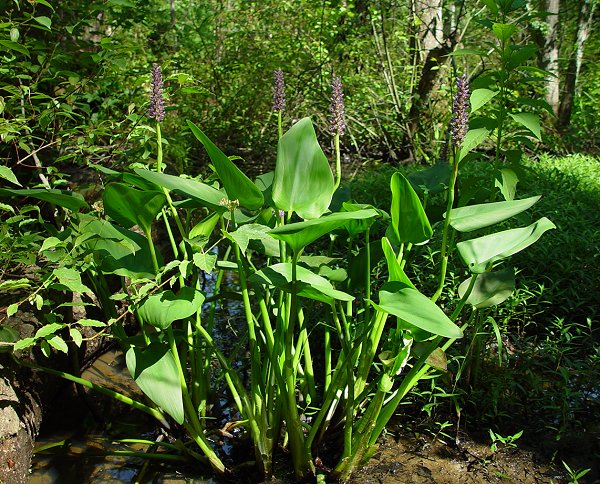Pontederia cordata L.
Pickerel Weed

Native
CC = 7
CW = -5
MOC = 22
© DETenaglia
Pontederia cordata L.Pickerel Weed | |
 |
Native CC = 7 CW = -5 MOC = 22 |
© DETenaglia |
|
Family - Pontederiaceae Habit - Perennial emergent aquatic forb. Stems - To 1 m tall, glabrous. Leaves - Basal and alternate. Petioles much longer than blades, with sheathing bases. Blades to 20 cm long, ovate to triangular, cordate, glabrous.
Inflorescence - Dense spike with numerous flowers.
Flowers - Perianth fused below the middle, 2-lipped, the lobes 6-10 mm long, lilac to purplish blue, the upper middle lobe with 2 yellow or white spots. Stamens 6, 3 longer and 3 shorter, the filaments attached near the middle of the anthers.
Fruits - Fruits utricles, 5-10 mm, long, ovoid, tapering to the persistent, coiled style base and enclosed by the persistent perianth tube, which is hard and roughened and develops 4-7 ridges with blunt teeth. Seeds 1 per fruit, 2-4 mm long.
Flowering - June - October. Habitat - Swamps, lakes, ponds, river bottoms. Origin - Native to the U.S. Lookalikes - None when flowering. Other info. - This striking species can be found in scattered locations throughout most of the state. It also occurs across most of the eastern half of the continental U.S., by far most commonly in coastal and Great Lakes regions. The plant is easy to ID in the field because of its growth habit, shiny green leaves, and showy inflorescences with yellow-spotted purple flowers. It is sometimes grown as an ornamental in garden ponds. Photographs taken in Brown Summit, NC., 6-10-02 (DETenaglia); also at Shaw Nature Reserve, Franklin County, MO, 6-26-2013 and 7-22-2020, and at Busch Wildlife Area, St. Charles County, MO, 7-29-2015 (SRTurner). |